THIS 14th ISSUE OF BYWAYS TAKES YOU ON A JOURNEY OVER THE HISTORIC SANTA FE TRAIL OF NORTHEASTERN NEW MEXICO, AS WELL AS TO A MEMORABLE SPOT ALONG THE TRAIL, CIMARRON
The Santa Fe Trail began in Franklin, Missouri and ended in Santa Fe. Although Indians had been using the route for centuries, it was officially established by William Becknell and his wagons of freight in late 1821. It was used by explorers, topographical engineers, mountain men and trappers, early settlers, traders of commerce vital to the new frontier, seekers of gold and other treasures, military expeditions and their journalists who accompanied them. The most important of the latter was the Army of the West, led by U.S. Brigadier General Stephen Watts Kearney, and Colonel of the First Regiment Missouri Volunteers, Alexander W. Doniphan. The journalists accompanying them recorded their not-so-easy journey, and their amazingly easy take-over, without firing a shot, of New Mexico from Mexico as the newest acquisition and territory of the United States.
Early Santa Fe Trail wagon travelers from Missouri and Kansas, wanting to avoid the hazardous high Raton Pass between Colorado and New Mexico, took the Cimarron Cut-Off that cut across a corner of the Oklahoma panhandle, entering New Mexico’s northeastern corner just above what is now Clayton and Kiowa National Grasslands. From there, that branch of the Trail headed southwesterly, passing beside the Point of Rocks (near the historic Dorsey Mansion at Chico Spring) where Indians ambushed a wagon-train, massacring the White family. That branch continued on past what is now Springer, crossing the Canadian River. From there onward to Santa Fe, I-25 now runs beside that branch of the old Santa Fe Trail. Deep wagon ruts can still be seen in places, attesting to the fact that for 1-1/2 centuries, settlers did not plow their prairies, but let their cattle roam, grazing the grass of the undisturbed land.
Why they called this route the Cimarron Cut-Off is hard to figure since this branch did not pass by Cimarron. From Springer, it went south to Wagon Mound, passing beside the volcanic formation that resembles a horse-drawn covered wagon, its sharply defined shape against the blue sky visible for many miles, rising up from the floor of the high prairie. That branch went onward, close beside I-25 that now follows it, to what is Watrous but was then called La Junta because at that spot two rivers joined. Just above La Junta, at Valmora, two branches of the Santa Fe Trail — this Cimarron Cut-Off and the Mountain Route — converged, becoming one again as it continued on to Santa Fe.
The Trail’s rugged Mountain Route — “the Santa Fe Trail via Bent’s Fort, 1822-1879”– came in from Colorado, crossed the high Raton Pass, entering New Mexico above what is now the town of Raton. At about where the NRA Whittington Center is now, in front of some of Colfax County’s coal-rich mesas, that route branched into two for a few miles. At that point, below a bare rock jutting above the mesa, those two smaller branches ran roughly parallel to each other, separated by just a few miles. Both crossed the Vermejo and the Cimarron rivers. The more westerly one passed through what is now the village of Cimarron in front of the mountains to its west, and both converged, becoming one again, near picturesque Rayado, now owned by the Boy Scouts of America.
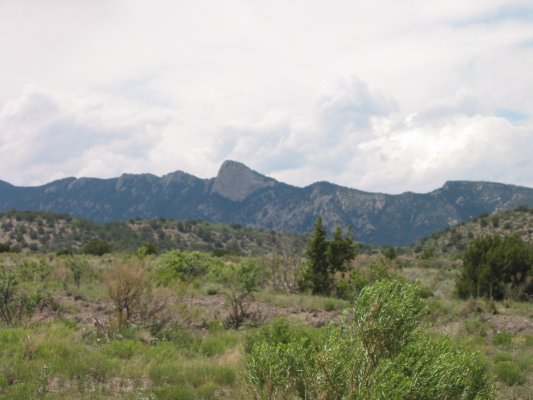
In the saddle of the mountains at Rayado, not far from the foot of the Tooth of Time rock formation, Kit Carson built one of his homes.
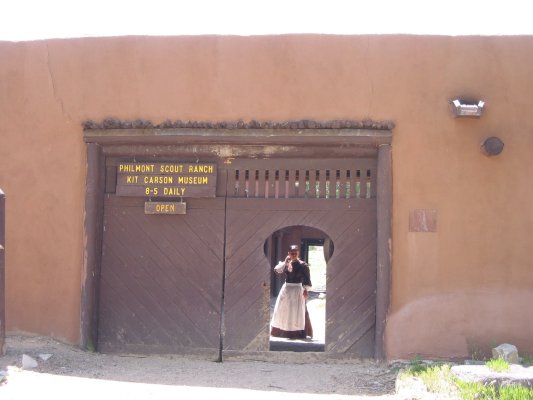
From Rayado, the Santa Fe Trail’s Mountain Route went south, passing through the high green valley at Ocate, crossing the Ocate Creek, then continued directly south, passing the spots where Fort Union was soon to be built, to the fertile grasslands of the Valmora and La Junta — where it joined with the Cimarron Cut-Off into the singular Santa Fe Trail that continued south to Las Vegas, then after a few miles, into a westerly direction to the Trail’s end destination, Santa Fe.
Until the construction of the Santa Fe Railway that was completed in northeastern New Mexico in 1879 and 1880, the Santa Fe Trail was a vital commercial trailway, linking the east to the fledgling west.
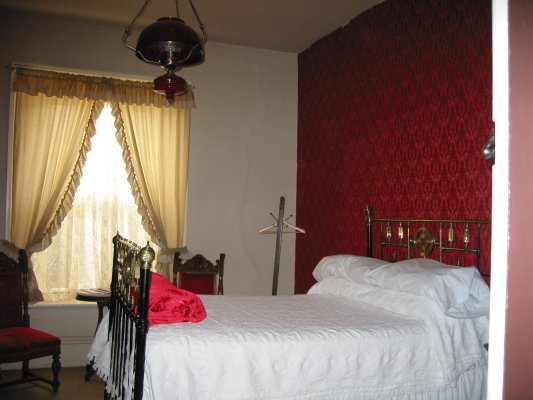
The village of Cimarron — at an elevation of 6,542 feet, situated on the eastern slope of the Sangre de Cristo mountains yet also alongside the great plains of northeastern New Mexico — is known for many things.
In the early and mid-1800s, it was known as a lawless place where famous bad guys hid out or flaunted their desperado ways, and where lawmen and others of famed repute also gathered. Some of its famous residents or visitors included Kit Carson, Buffalo Bill Cody, Annie Oakley, Wyatt Earp, bad-boys brothers Frank and Jesse James, Clay Allison and bank and train robber Black Jack Ketchum. Even Billy the Kid Bonney of southeastern New Mexico visited.
It was known as the seat of the vast 1,714,765 acre Maxwell Land Grant because that was where its grantee, Lucien B. Maxwell, built his second home, 10 years after establishing his first headquarters.
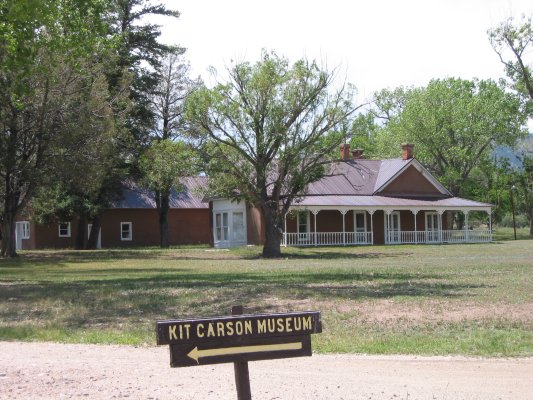
His first was built in 1848 beside the Rayado River. He later gave that land and home to his wife’s brother, Jesus Abreu (born 1823, died 1900), and moved his operations, building his newer home in 1858 on the banks of the Cimarron River, at what is now the village of Cimarron, but then named “Maxwell’s Ranché.” His was a place well known for its open hospitality to anyone who stopped by.
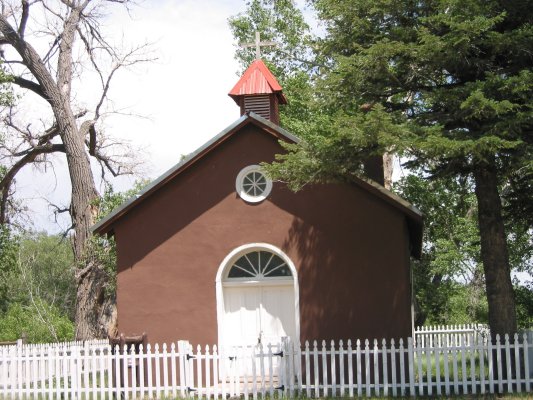
A fur trapper from Illinois, Maxwell met French-Canadian Charles Beaubien, who established his Mexican citizenship in 1827 after marrying an Hispanic woman from a prominent New Mexico family. By 1840, Beaubien had become a wealthy property-owner in Taos. Maxwell married his friend’s lovely eldest daughter, Luz, and they had nine children.
(An interesting side-note: The eldest of those nine was son, Peter Maxwell. On July 14, 1881, Sheriff Pat Garrett gunned down Billy “the Kid” Bonney in Pete’s dark bedroom at Lucien B. Maxwell’s final home at Fort Sumner. Billy had been sweet on Pete’s next-to-the-youngest sister, Paulita, and perhaps she was pregnant with the Kid’s child. Resenting that might have been a reason Pete betrayed Billy’s whereabouts to Garrett. That betrayal was one of several unproven speculations about Garrett successfully killing the Kid. Deluvina Maxwell — an Indian girl adopted by the Maxwells — was another Maxwell who loved him and was present at Fort Sumner that dark night when the Kid died.)
Maxwell had sold the Grant and moved to Fort Sumner. After he sold it for $1,350,000 to a group of English investors in 1870, the new owners began trying to get rid of the many settlers and Indians on the land, which resulted in the 1875 Colfax County War. Ownership of the grant land changed hands several more times, next to a Dutch investment group.
Presently, most of the grant land is owned by four private ranches: the vast Vermejo Park (WS) Ranch, now owned by media mogul Ted Turner; the UU Bar Ranch that has been, off and on, embroiled in disputes with hunters wanting hunting access to federal lands; the CS (Charles Springer) Ranch, long-time owned by respected ranchers Les and Linda Mitchell Davis; and the Philmont Scout Ranch. A large part of the original grant is also managed by the National Forest Service.
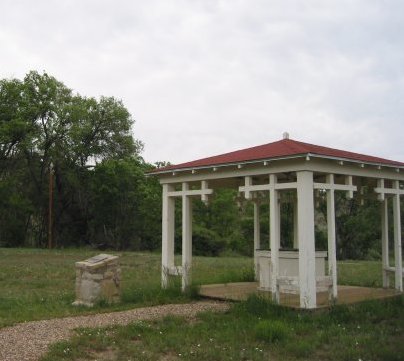
In the communal campground in a central plaza of Cimarron, at the point where the Santa Fe Trail entered the town, a well was dug in 1871. It benefited the freighters and their beasts of burden as they passed through hauling goods from Kansas Territory to Fort Union. The gazebo was reconstructed in 1962 based upon early photographs.
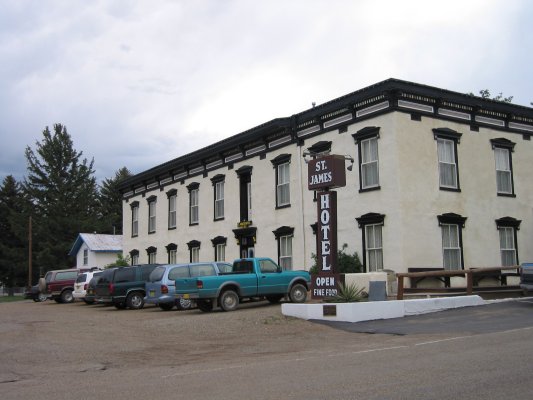
The St. James Hotel was built in 1880 by Henri Lambert — once cook for General Grant and President Abraham Lincoln. In that historic building, at least 26 murders were committed. Many years later, Henri’s son, Fred Lambert, in slightly more modern times also a memorable Cimarron figure, became instrumental in preserving the old Aztec Grist Mill and turning it into a museum.
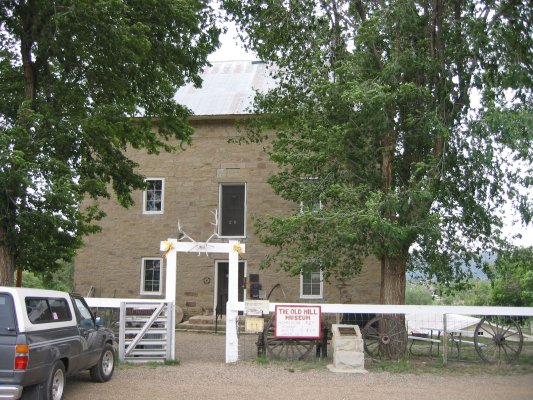
The Mill was originally built to provide wheat and corn flour for local residents and soldiers. When the Indian Agency at Taos was relocated to Cimarron in 1861, from the Mill blankets, food and other staples were dispensed to the Indians. In 1875, there was a minor Indian uprising at the Mill. In 1876, the Indian Agency at Cimarron was closed and the Indians were moved to a reservation in northwestern New Mexico and Colorado.
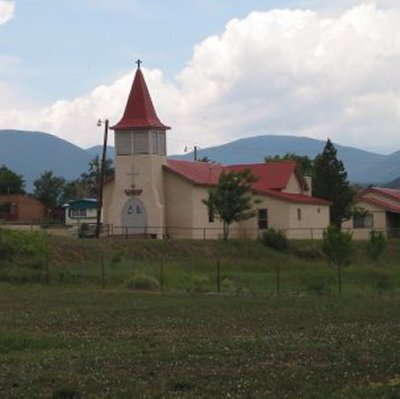
After the deaths of two of their children, Verenisa and Julian, in their memory Lucien and Luz Maxwell built the Immaculate Conception Church in Cimarron in 1864. Jean Baptiste Lamy, Santa Fe’s first Bishop, dedicated it, which began as a mission church. It was enlarged in 1909 and the new bell and bell-tower were dedicated the next year.

Two graves — that of Verenisa Maxwell (1860-1864) and the child’s maternal grandmother, Maria Pabla Beaubien (1811-1864) — were placed behind Maxwell’s family home at Cimarron. The large two-story Maxwell Ranché building partially burned in 1888 and the rest was destroyed by fire in 1924. The original Maxwell home is gone but the gravesites remain. Pabla was the wife of one of the two original land grantees, Charles Beaubien (1800-1864).

Stockyards, warehouses and supply stores were vital for the safekeeping and selling of the goods and wares hauled or driven over the Trail. A Cimarron building, first built by M.R. Whiteman as a freighting depot for the Andres Daws stage line, was later used as a warehouse by the Dold Brothers who ran a freight line between Missouri and Las Vegas, New Mexico. It was a trading post and Indian Agency in 1861, and also Lucien Maxwell’s commissary. Asa F. Middaugh and Henry Miller Porter, 12 years later, used it briefly as a general store, and for a while, it was also the home of Cimarron News and Press. Since 1908, it has been the private home of the Lail family.
Cimarron is now somewhat off the beaten path, but it was once on a path well traveled and an important town on the western frontier. After almost daily rains for many weeks, its setting is now green and as crisp as the mountain air surrounding it. Historic Cimarron is a great place to visit or stay a while. The St. James has its welcome mat out, a place set and a bed made. In fact, they even have a lamp or two burning for you.
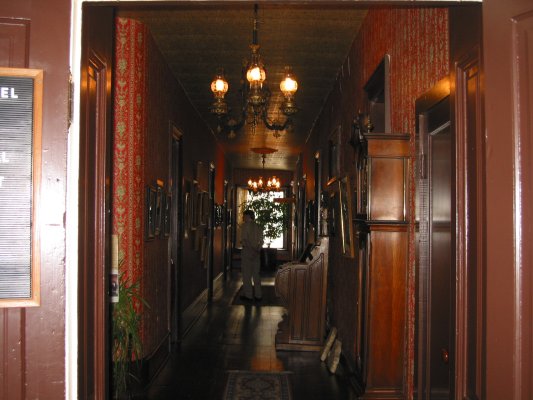
A wild west murder adventure even awaits if you book your room during “A Mystery Weekend at the St. James Hotel.” The price includes the murder mystery (you are one of the actors who solve the mystery), a room for two nights, furnished with antiques, meals and entertainment. (Call 1-866-472-5019 for more information.)
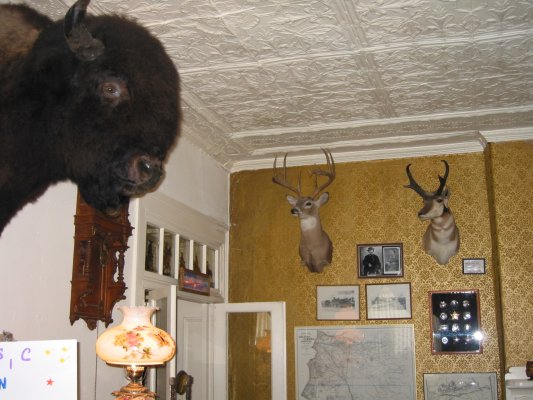
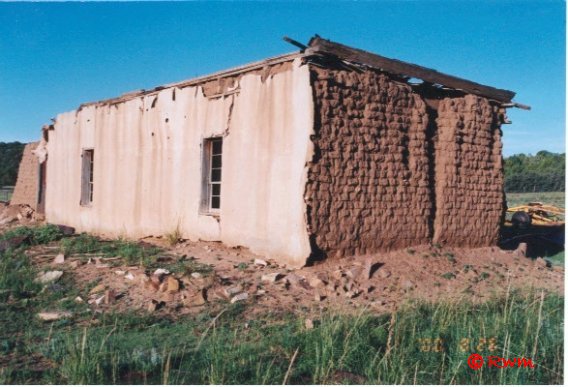
When they marched over Bonney’s land at La Junta, James Bonney marched – briefly and unmemorably to all but a few who cared – into recorded history.
Those various early-day journalists, historians and descendents of James Bonney said he was born in England or that he was a blue-eyed Irishman from the British Isles. He was described as handsome, with red hair and beard. That he had blue eyes has never been disputed. Those blue eyes, which must have been a dominant gene, have passed down for generations.
James immigrated to the United States, some stories say a brother came with him, and he settled in Missouri – where and about when the Santa Fe Trail began.
For a while, it was said, he ran a successful freighting business over the Trail from Missouri to Santa Fe and back again. About 1825, he began a settlement at what was then called La Junta – the junction – because of the fertile valley made by the crossing of two rivers, the Mora and the Sapello.
He settled in northern New Mexico and began another family. Bonney carefully chose the site for his trading post. It was Mora grant land given to him by his new father-in-law, Miguel Mascarenas, located at the lower plaza. The place he wanted, and which Miguel deeded to him, was beside the Santa Fe Trail. In fact, it was near where two of the Trail’s branches – the Mountain Branch and the Jornada or Cimarron Cutoff with the Ocate Crossing – joined and became one before it went on to Santa Fe. It was also beside the trail that went west, up over the mountain to the high valley of lo de Moro where a settlement of grantees – one of the earliest white settlements in New Mexico – was already established on the upper plaza.
The summer of 1846, U.S. Brigadier General Stephen Watts Kearney and his Army of the West passed through New Mexico and, without firing a shot, successfully claimed it for the United States from Mexico. When the battalions led by Kearney – one under the command of Alexander W. Doniphan, Colonel First Regiment Missouri Volunteers – marched over the Santa Fe Trail that had begun 25 years earlier, they passed through the “civilized valley” of La Junta. The soldiers considered it civilized because it had plentiful water, fine grass, flocks of sheep, droves of horses, and large herds of cattle. James Bonney had a settlement there, and the dugout dwelling, log cabin, trading post, livestock, garden and animal pens those early journalists wrote of were his.
Just a few years earlier, Bonney had hired Mexican laborers to dig an irrigation ditch from the junction of the two rivers to the higher ground where he built his settlement and trading post. That ditch, still functioning in the new millennium, is called the Bonney Ditch.
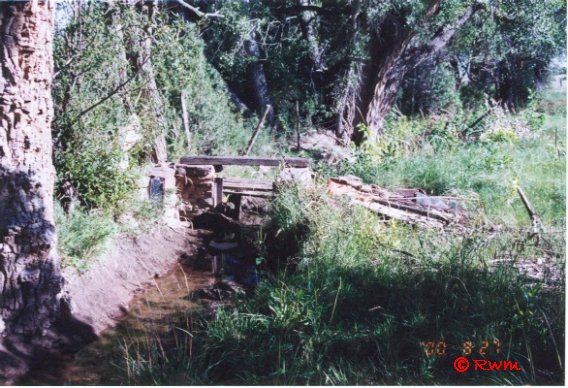
“The first settlement we had seen in 775 miles,” wrote Lieutenant Emery, a journalist with the Army of the West. He also wrote, “Mr. Boney (sic) … has been some time in this country, and is the owner of a large number of horses and cattle which he manages to keep in defiance of wolves, Indians and Mexicans. He is a perfect specimen of a generous, openhearted adventurer, and in appearance what, I have pictured to myself, Daniel Boone of Kentucky must have been in his day. He drove a heard of cattle into camp and picked out the largest and fattest, which he presented to the Army.”
Another early-day journalist who met him recorded that Bonney had red hair and beard and was an Englishman.
The battalions led by Kearney were guests of James Bonney on the night of August 13, 1846. His wet and bedraggled guests on the second night were those of the artillery battalion commanded by Doniphan, slowed by their wagons and cannons and the inclement weather. This is history recorded in several early records and journals.
Lore that passed down verbally for generations from Bibiana Martin’s family and from New Mexico descendents of Bonney have said too, that those two groups of American soldiers spent those two nights camped beside the river on Bonney land and for their evening meals, James had fed them his choicest beef.
1846 was a memorable year for the very young Bibiana. Her son, Ramon, by James was born and soon after had come armies of American soldiers, the first she had ever seen, who were brief guests of her family. Less than two months later, James Bonney was killed in early October, not far from his home.
Indians had stolen some of his horses; the next morning, while the signs were still fresh for tracking, James took an Indian servant for translation, and a bag of freshly made tortillas for barter, and went in pursuit of his horses.
His arrow-studded body was later found beside Dog Creek, beyond Valmora. It is said that he was buried in what later became the Tiptonville cemetery. There are still some who believe they can identify his unmarked grave.

No American forts had yet been built along the Santa Fe Trail, because the Territory had only just become property of the United States, but soon there would be many. In 1851, Fort Union was built – near what had been James Bonney’s trading post. The fort was, perhaps, built upon Bonney land. At any rate, Bonney’s grown children told Fort Union they owed them rent.
In New Mexico are many descendents of James Bonney. Most of them come from Cleofas, Santiago (James Bonney, Jr.) and Rafaela – his three children by Juana Maria Mascarenas. Juana was the daughter of Miguel Mascarenas, the 42nd grantee of the Mora Land Grant. That liaison was recognized in early New Mexico court documents.
Some descendents also come from Ramon, the son of James and Maria Bibiana Martin, the daughter of Apolonia and Bernardo Martin, the 40th grantee of the Mora Land Grant. The one between James and the very young Bibiana was his second child-producing relationship in New Mexico, but his third known family.
James had an earlier relationship or marriage in Missouri that produced children. Historian, Herman Weisner, connected a blue-eyed Englishman named James Bonney to a family in Missouri. Into that family, said my friend and published historian, was born a child named Catherine who might have later become the mother of Billy the Kid Bonney. He found several coincidences or links to believe that was a possiblity. Herman died in January 2003 without fully proving his theory.
In the middle of the year 2001, I traveled back 150 or 175 years in one hour of one day. What transported me was being told that I stood upon the site where James Bonney had built his dugout dwelling, store and trading post along the Santa Fe Trail in the early 1800s. Who transported me was 80-year-old Joe Lopez who has startlingly blue eyes. He said he got them from his great-great-grandfather, James Bonney. Joe owns some of that land that Bonney had owned so long ago. That included the site where we stood that day.

Years after James Bonney’s death, his Mascarenas descendents legally fought for and regained ownership to his lands from Samuel B. Watrous, Tipton and other settlers of the area who had taken possession of them after Bonney died.
The settlement, known as La Junta 150 years ago in northeastern New Mexico, was renamed Watrous. Also in the area of Watrous had been two other settlements. The better known one was called Tiptonville after an early area settler.
After James Bonney’s adult children by Juana regained his lands – Rafaela’s husband, Trinidad Lopez, founded the other settlement. Soldiers at Ft. Union recommended to Trinidad – who had himself once been a lieutenant, Company A, First Infantry stationed at Ft. Union – to establish a community to protect himself and his family from Indian attacks. The adage of “safety in numbers” was then even more poignant. Trinidad named the settlement Bonneyville.
Cleofas, Santiago and Rafaela and their families built their adobe homes there, as did many others. The three adobe Bonney abodes still stand, but only one or two non-Bonney abodes remain. Still, if you look closely and know what you are looking at, you can see foundations and indentations, stones and adobe, the earthly remains of Bonneyville, as well as a Jesuit church founded by Cleofas.
Although I am not descended from James Bonney, he has always fascinated me because Bibiana Martin was my great-great-grandmother. She later had other children in addition to Ramon.
Ramon Bonney, son of James, traveled to visit Billy “the Kid” Bonney, while he was incarcerated in Las Vegas, New Mexico, to find out if they were kin. Many modern-day descendents of James Bonney say the answer was yes, some are still uncertain. Quien Sabe?
A BONNEY BALLAD
there was a boy called Billy in the Territory of New Mexico.
Now Billy wasn’t his name back at the beginning of his life;
they say that it was Henry and he was born to one then not a wife.
His mama’s name was Catherine, and he had a brother named Joe.
His mama’s last name was McCarty, so too was his and Joe’s.
Most historians say Henry McCarty was born without a dad
in New York to an Irish lassie and the way they lived was sad.
Our Henry had arrived there on his birthing day
in an Irish slum in 1859, so some historians say.
Still, little is known about him, back in his early years
except knowing how to feed him was his mama’s greatest fear.
They lived a while in Kansas, made a stopover in Denver too;
why they landed in New Mexico, historians have no clue.
What was it drove them onward? Why did they end up here?
Were they searching for a better life, or was it plain despair?
Some say their lives got better before arriving here
’cause Catherine took a partner to share her load with her.
At any rate, they came here, to live in this wild place,
Catherine, Joe, Henry — and Will, a guy historians trace
to Kansas on the plains, a place called Wichita.
Even then, young Henry called William Pa.
So, long before they got here, they’d ambled other places,
frustrating historians by leaving few traces.
Census, courts and archives, even churches cast
few if any clues upon our mysterious Billy’s past.
One thing they know for certain (at least they think they do) —
the Santa Fe Book of Marriages holds their first recorded clue.
The widow, Catherine McCarty, in Santa Fe, New Mexico,
stood with Henry and Josie (what they called her boy Joe) —
as she said her wedding vows, the boys stood up with them
at First Presbyterian with her and William Henry Antrim.
That was the first known record establishing when he —
our Bonney lad — was in New Mexico: that was in 1873.
Like his mom, Henry McCarty right then changed his name
to Antrim. “William or Will like my new pa, if it’s all the same.”
Confusing historians, he was Henry McCarty just the same,
but William Henry Antrim right then became his name.
In Santa Fe the Antrims’ days of wandering still weren’t done;
they traveled to Silver City to bask in its arid sun.
It was there the young William Antrim, called Will,
took yet another name. “Just call me The Kid or Bill.”
Then his beloved mother died of consumption or T.B.
It broke the heart of Billy; a boy he’d no longer be,
for there the young lad, Billy, began his criminality.
On a lark he stole some clothes from a Chinaman’s laundry.
It was only for the fun of it, but the sheriff did not laugh.
The Kid was thrown in jail but his lock-up did not last.
The Kid determined a little space with just a cot and pail
was not to be the end of this, our cunning Billy’s tale.
He conned the sheriff’s deputy, and knew well how to shimmy
so he made quick his escape right up that red brick chimney.
That proved to him and all the rest his wiles and slippery ways,
and that was just the beginning of his desperado days.
(Now what could you expect, since Billy’s home life wasn’t sound?
And his step-dad didn’t care much to have the boy around?)
He was a homely kid, buck-teeth and prominent ears,
so he relied upon his ways of charm and lack of boyish fears
to win him loyal friendships, cause girls to think him cute.
Still, his winning way was because … boy, could he shoot!
So … who was our Henry McCarty, William H. Bonney, “The Kid?”
Where did he come from, who was his ma, why did he do what he did?
Of his latter years (alas, so few), we know his story well
for many, including Pat Garrett, his stories loved to tell.
His antics, shoot-outs, hot pursuits are documented well
in books, in movies and in songs, stretched out so they would sell.
And sell they did, even in England, for folks there love a tale —
of strife, romance and intrigue as they quaff their brew and ale.
***
(To see earlier portions of this poem, click the Archives button and go to Byway pages of the previous issues.)
The origins and genealogy of Billy “The Kid” Bonney and his early life remain a mystery. So too is the mystery of why he, in the latter portion of his short life, adopted the name Bonney. Most published historians think that: a.) He began life in New York as Henry McCarty; b.) He changed his name to William Henry Antrim to match his stepfather’s after his mother’s marriage in Santa Fe in 1873; and c.) He adopted the name William H. or Billy Bonney in the last years of his life. Historians don’t know from where he acquired or why he adopted the Bonney name. Serious historians admit that they are uncertain of his origins, but think he might have been born in a New York City Irish slum in 1859. Both the place and the date of his birth could be incorrect.
Rwm
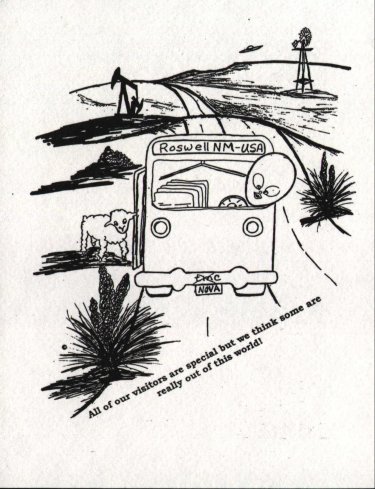
“All of our visitors are special, but we think some are really out of this world!”
Rwm
 Roswell Web Magazine
Roswell Web Magazine